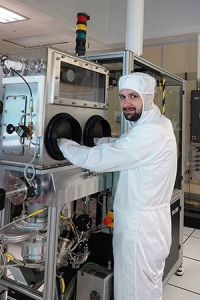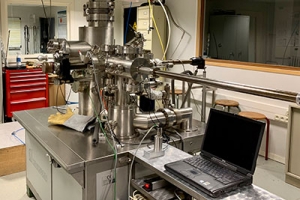Crossed portraits of two young nuggets of the IEMN
The C’Nano prize was awarded in 2020 for their thesis work to Maxime Hallot in the field of micro-storage and to Nathali Franchina Vergel on artificial graphene.
Maxime Hallot « Place a last brick »
Maxime has designed miniatures batteries based on the alloy of lithium materials. These so-called solid state batteries are developed in 3D architecture, which gives them a high storage capacity.
« The challenge of the years 2010-2020 is to design batteries with high energy densities in very small spaces. We can take the image of a lung: its complex tree-like structure, composed of alveoli ending in capillaries, allows an optimal gas exchange with the air. »
His project dedicates several years of research on the subject. His predecessor had worked in 3D architecture but on a half battery. Now, a battery is composed of (at least) 6 layers of materials.
« Thanks to my thesis work, I have laid the final brick. With the stacking of all the layers of materials in 3D, I have validated the fabrication of a complete device! »
After an integrated preparatory school at ISEN, Maxime continued his engineering studies and obtained a master’s degree in communicating systems at the University of Lille with a major in nano and microtechnologies, where he developed a strong interest in energy storage and conversion. There, he met Christophe Lethien, his thesis director, who steered him towards promising themes.
For Maxime, the challenge of his research lay in the design of all-solid batteries because the electrolyte, the conductive substance that separates two electrodes and allows the exchange of ions, is composed of liquid solvents.
« One difficulty was to carry out all the material synthesis on a 3D architecture that uses advanced deposition techniques called « atomic layer deposition or ALD. »
Maxime’s work is in the maturation phase. He wishes to continue working in the field of renewable energy. He plans to extend his prototype to a global project of energy storage systems for other types of batteries or components. The result is a startup with a future, housed at IEMN!
You have both contributed to a lot of micro and nanotechnology developments in cleanrooms. How would you describe your experience?
NATHALI : « I really like working in the clean room! First of all, it requires preparation and a lot of patience. On the other hand, the collaboration between technicians, engineers, and researchers was remarkable, at IEMN, it’s like a big family! »
MAXIME : « Yes, first of all, it is an essential teamwork! It’s also fascinating because we get to observe very specific phenomena. I would say that working in a clean room is both a constant challenge and a daily discovery. »
Nathali Franchina Vergel : A complete alliance
of fundamental physics and micro and nanotechnology development
Nathali’s work is inspired by graphene, a material with exceptional electrical and technical properties, named in 1986. This material is found naturally in graphite crystals. Researchers discovered it in 2004 by using the adhesive strip of a roll of scotch tape to exfoliate layers of graphite. « Its characteristics are unique: both strong and light, an excellent thermal conductor, deformable and transparent; however, it is difficult to synthesize and couple with other materials. » Nathali got around the difficulty by creating an artificial material that mimics the characteristics of graphene:
« We made a honeycomb structure by making holes in III-V semiconductors to mimic the organization of carbon atoms in graphene, based on quantum physics. »
To observe quantum phenomena, one must work at a microscopic scale such that the electrons behave mainly as waves. There, as the atoms get closer together, the behavior of the electrons changes: « this is why a range of different techniques was tested to try to create the smallest possible honeycomb structure. » For the fabrication, the researcher used the many resources of the IEMN clean room: electronic lithography, molecular jet growth, dry etching, …
The manufacture of the innovative material was accompanied by its characterization using electronic and electrical measurements and a lot of instrumentation.
« Near-field characterization is my area of specialization. I learned how to use a scanning tunneling microscope (STM). It allows us to see how electrons behave inside materials. »
Today, Bruno Grandidier and Christophe Delerue’s doctoral student has joined IMEC (Institute of Microelectronics and Components), in Belgium, as a research engineer where she is involved in the creation of components and circuits. At IEMN, she specialized in dry etching techniques, which she reinvests in her new job: « I use my expertise in dry etching but in other fields such as magnetic or phase change memories. » In other words, a successful transfer of skills!
Writing: Karine Perrot
















